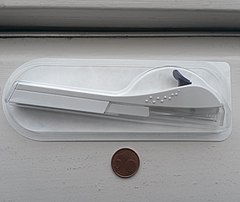
Back غرسات منع الحمل Arabic Anticonceptiu subdèrmic Catalan Anticonceptivo subdérmico Spanish Implant contraceptif hormonal French Ենթամաշկային իմպլանտ Armenian Kontrasepsi implan ID Impianto contraccettivo ormonale sottocutaneo Italian गर्भनिरोधक प्रत्यारोपण (इम्प्लान्ट) Nepali Implant antykoncepcyjny Polish Implante contracetivo Portuguese
| Contraceptive implant | |
|---|---|
 Container/applicator for Nexplanon, an example of an etonogestrel-based contraceptive implant | |
| Background | |
| Type | Long-acting reversible contraception |
| First use | ? |
| Trade names | Implanon/Nexplanon, Jadelle |
| Failure rates (first year) | |
| Perfect use | 0.05%[1][2] |
| Typical use | 0.05%[1][2] |
| Usage | |
| Duration effect | 3–5 years |
| User reminders | None |
| Advantages and disadvantages | |
| STI protection | No protection |
A contraceptive implant is an implantable medical device used for the purpose of birth control. The implant may depend on the timed release of hormones to hinder ovulation or sperm development, the ability of copper to act as a natural spermicide within the uterus, or it may work using a non-hormonal, physical blocking mechanism. As with other contraceptives, a contraceptive implant is designed to prevent pregnancy, but it does not protect against sexually transmitted infections.
- ^ a b Trussell J (May 2011). "Contraceptive failure in the United States". Contraception. 83 (5): 397–404. doi:10.1016/j.contraception.2011.01.021. PMC 3638209. PMID 21477680.
- ^ a b Sivin I, Campodonico I, Kiriwat O, Holma P, Diaz S, Wan L, Biswas A, Viegas O, et al. (December 1998). "The performance of levonorgestrel rod and Norplant contraceptive implants: a 5 year randomized study". Human Reproduction. 13 (12): 3371–8. doi:10.1093/humrep/13.12.3371. PMID 9886517.
© MMXXIII Rich X Search. We shall prevail. All rights reserved. Rich X Search